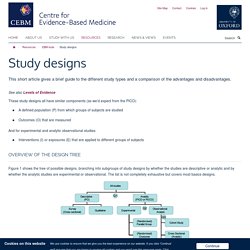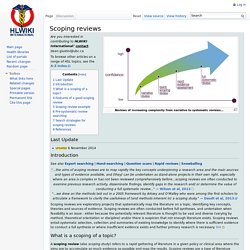

Het vervelende daarbij is dat er vaak een alleen een soort omschrijving staat en dan moet jij daaruit kunnen concluderen welk onderzoekstype het is...
Hierbij links met die uitleg geven over onderzoekstypen. Meestal pak ik ook het boek "Onderzoek in de Gezondheidszorg" erbij.
Study designs — Centre for Evidence-Based Medicine (CEBM), University of Oxford. See also Levels of Evidence These study designs all have similar components (as we’d expect from the PICO): A defined population (P) from which groups of subjects are studied Outcomes (O) that are measured And for experimental and analytic observational studies: Interventions (I) or exposures (E) that are applied to different groups of subjects Overview of the design tree Figure 1 shows the tree of possible designs, branching into subgroups of study designs by whether the studies are descriptive or analytic and by whether the analytic studies are experimental or observational.

Figure: Tree of different types of studies (Q1, 2, and 3 refer to the three questions below) > Download a PDF by Jeremy Howick about study designs Our first distinction is whether the study is analytic or non-analytic. An analytic study attempts to quantify the relationship between two factors, that is, the effect of an intervention (I) or exposure (E) on an outcome (O). Spotting the study design Q1. Q2. Yes? Q3. Checklist beoordeling type onderzoek. Scoping reviews - HLWIKI Canada. Reviews of increasing complexity from narrative to systematic reviews...

Are you interested in contributing to HLWIKI International? Contact: dean.giustini@ubc.ca To browse other articles on a range of HSL topics, see the A-Z index. Last Update 6 November 2014 Introduction See also Expert searching | Hand-searching | Question scans | Rapid reviews | Snowballing "...the aims of scoping reviews are to map rapidly the key concepts underpinning a research area and the main sources and types of evidence available, and [they] can be undertaken as stand-alone projects in their own right, especially where an area is complex or has not been reviewed comprehensively before...scoping reviews are often conducted to examine previous research activity, disseminate findings, identify gaps in the research and/ or determine the value of conducting a full systematic review...
" — Wilson et al, 2012. Differences between narrative, scoping and systematic reviews_University of South Australia. Learn About Clinical Studies - ClinicalTrials.gov. Contents What Is a Clinical Study?

A clinical study involves research using human volunteers (also called participants) that is intended to add to medical knowledge. There are two main types of clinical studies: clinical trials (also called interventional studies) and observational studies. ClinicalTrials.gov includes both interventional and observational studies. Clinical Trials In a clinical trial, participants receive specific interventions according to the research plan or protocol created by the investigators.
Clinical trials used in drug development are sometimes described by phase. Some people who are not eligible to participate in a clinical trial may be able to get experimental drugs or devices outside of a clinical trial through an Expanded Access Program. Observational Studies In an observational study, investigators assess health outcomes in groups of participants according to a research plan or protocol. Algorithm for classifying quantitative (experimental and observational) study designs.
Guide for Authors. 6 Article types that journals publish: A guide for early career researchers. The field of research requires persistence and most researchers devote many a sleepless night towards conducting research and documenting results.

In the competitive world of academia, you are expected to start publishing early in your career, and many early-career researchers are faced with the looming worry of how to publish a journal article. Although original research sometimes takes years to complete, it does not mean you cannot have any publications to your credit till the time you complete your research. There are different types of scholarly literature, some of which require original research (categorized as primary literature) and some that are based on other published work (secondary literature). It is important to have a clear idea about the different types of articles that you can publish in journals.
This will help you understand the ways in which you can disseminate your work and identify what kind of article would be suitable for your study. 1. 2. 3. 4. 5. 6. Bibliography: